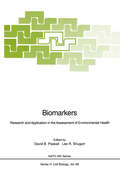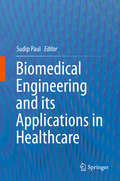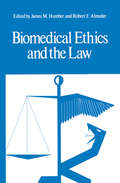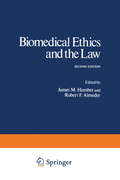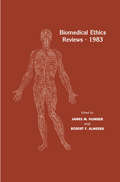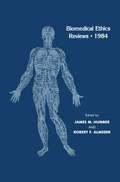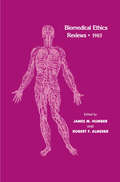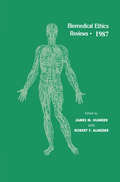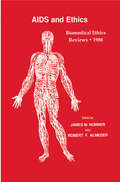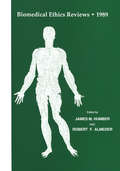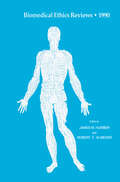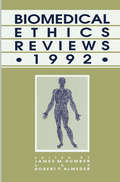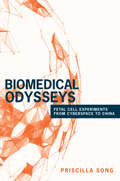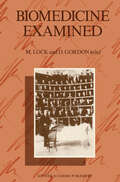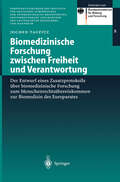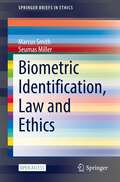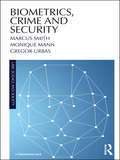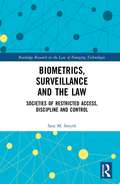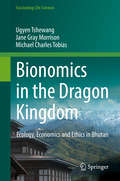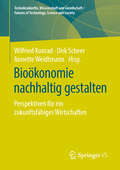- Table View
- List View
Biomarkers: Research and Application in the Assessment of Environmental Health (Nato ASI Subseries H: #68)
by David B. Peakall Lee R. ShugartBiological markers used to assess the effects of environmental pollution have attracted considerable attention from regulatory agencies and are currently under evaluation at a number of research facilities throughout the world. However promising a biomarker-based biomonitoring approach may be, the development of this concept is complicated by a range of technical issues. This book provides a conceptional framework for research and application of biomarkers. International experts on biomonitoring have formulated a unified strategy for the development and validation of biomarkers in assessing environmental health as well as appropriate protocols for their implementation and interpretation in a biological monitoring program.
Biomedical Engineering and its Applications in Healthcare
by Sudip PaulThis book illustrates the significance of biomedical engineering in modern healthcare systems. Biomedical engineering plays an important role in a range of areas, from diagnosis and analysis to treatment and recovery and has entered the public consciousness through the proliferation of implantable medical devices, such as pacemakers and artificial hips, as well as the more futuristic technologies such as stem cell engineering and 3-D printing of biological organs. Starting with an introduction to biomedical engineering, the book then discusses various tools and techniques for medical diagnostics and treatment and recent advances. It also provides comprehensive and integrated information on rehabilitation engineering, including the design of artificial body parts, and the underlying principles, and standards. It also presents a conceptual framework to clarify the relationship between ethical policies in medical practice and philosophical moral reasoning. Lastly, the book highlights a number of challenges associated with modern healthcare technologies.
Biomedical Ethics and the Law
by James M. Humber Robert F. AlmederIn the past few years an increasing number of colleges and universities have added courses in biomedical ethics to their curricula. To some extent, these additions serve to satisfy student demands for "relevance. " But it is also true that such changes reflect a deepening desire on the part of the academic community to deal effectively with a host of problems which must be solved if we are to have a health-care delivery system which is efficient, humane, and just. To a large degree, these problems are the unique result of both rapidly changing moral values and dramatic advances in biomedical technology. The past decade has witnessed sudden and conspicuous controversy over the morality and legality of new practices relating to abortion, therapy for the mentally ill, experimentation using human subjects, forms of genetic interven tion, suicide, and euthanasia. Malpractice suits abound and astronomical fees for malpractice insurance threaten the very possibility of medical and health-care practice. Without the backing of a clear moral consensus, the law is frequently forced into resolving these conflicts only to see the moral issues involved still hotly debated and the validity of existing law further questioned. In the case of abortion, for example, the laws have changed radically, and the widely pub licized recent conviction of Dr. Edelin in Boston has done little to foster a moral consensus or even render the exact status of the law beyond reasonable question.
Biomedical Ethics and the Law
by James M. Humber Robert F. AlmederIn the past few years, an increasing number of colleges and universities have added courses in biomedical ethics to their curricula. To some extent, these additions serve to satisfy student demands for "relevance. " But it is also true that such changes reflect a deepening desire on the part of the academic community to deal effectively with a host of problems which must be solved if we are to have a health-care delivery system which is efficient, humane, and just. To a large degree, these problems are the unique result of both rapidly changing moral values and dramatic advances in biomedical technology. The past decade has witnessed sudden and conspicuous controversy over the morality and legality of new practices relating to abortion, therapy for the mentally ill, experimentation using human subjects, forms of genetic interven tion, and euthanasia. Malpractice suits abound, and astronomical fees for malpractice insurance threaten the very possibility of medical and health-care practice. Without the backing of a clear moral consensus, the law is frequently forced into resolving these conflicts only to see the moral issues involved still hotly debated and the validity of the existing law further questioned. Take abortion, for example. Rather than settling the legal issue, the Supreme Court's original abortion decision in Roe v. Wade (1973), seems only to have spurred further legal debate. And of course, whether or not abortion is a mo rally ac ceptable procedure is still the subject of heated dispute.
Biomedical Ethics Reviews · 1983 (Biomedical Ethics Reviews)
by James M. Humber Robert F. AlmederIn the past decade the body of literature in the area of biomedical ethics has expanded at an astounding rate. Indeed, on every major topic, the literature in this area has mUltiplied, and continues to do so, so rapidly that one can easily fall behind important advances in our thinking about and understanding of the problems of contemporary bioethics. Awareness of this need to keep apace of developments in the area prompted a recent reviewer of our earlier collection Biomedical Ethics and the Law (Plenum, 2nd edition, 1979) to suggest that somebody ought to offer the service of providing a biennial review or update of the literature on the various central topics in bioethics. Thomas Lanigan, of The Humana Press, agreed with this last sug gestion and so asked us to edit a series of texts consisting of previously unpublished essays on selected topics, a series that would seek to re view and update recent literature on the central topics, while also striv ing to advance distinctive solutions to the problems on the topics under discussion. Accordingly, this first collection of previously unpublished essays focuses on the selected topics, and the authors commissioned were charged with addressing the basic problems assigned while also bringing the reader either directly or indirectly up to date on the rele vant literature.
Biomedical Ethics Reviews · 1984 (Biomedical Ethics Reviews)
by James M. Humber Robert F. AlmederThis is the second volume of Biomedical Ethics Reviews, a series of texts designed to review and update the literature on issues of central importance in bioethics today. Five topics are dis cussed in the present volume. Section I, Public Policy andRe search with Human Subjects, reviews the history of the moral issues involved in the history of research with human subjects, and confronts most of the major legal and moral problems involving research on human subjects. Questions addressed in this section range from those concerning informed and proxy consent to those dealing with the adequacy of monitoring hu man research via institutional review boards (IRBs). Section II deals with a second broad topic in bioethics, The Right to Health Care in a Democratic Society. Here the concern not merely that of determining whether there is a right to is health care, but also, if there is such a right, how it ought best be understood and implemented. To answer questions such as these, we learn that one must distinguish legal from moral rights, assess the merits of various theories of rights, clarify the relationship between rights and duties, and attempt to deter mine a just method for the distribution of health care. Advances in medical technology often pose new legal and moral problems for legislators and health care practitioners.
Biomedical Ethics Reviews · 1985 (Biomedical Ethics Reviews)
by James M. Humber Robert F. AlmederBiomedical Ethics Reviews: 1985 is the third volume in a series of texts designed to review and update the literature on issues of central impor tance in bioethics today. Four topics are discussed in the present volume: ( 1) Should citizens of the United States be permitted to buy, sell, and broker human organs? (2) Should sex preselection be legally proscribed? (3) What decision-making procedure should medical per sonnel employ in those cases where there is a high degree of uncer tainty? (4) What do we mean when we use the terms "health" and "disease"? Each topic constitutes a separate section in our text; intro ductory essays briefly summarize the contents of each section. Bioethics is, by its nature, interdisciplinary in character. Recognizing this fact, the authors represented in the present volume have made every effort to minimize the use of technical jargon. At the same time, we believe the purpose of providing a review of the recent literature, as well as of advancing bioethical discussion, is admirably served by the pieces collected herein. We look forward to the next volume in our series, and very much hope the reader will also.
Biomedical Ethics Reviews · 1987 (Biomedical Ethics Reviews)
by James M. Humber Robert F. AlmederBiomedical Ethics Reviews • 1987 is the fifth volume in a series of texts designed to review and update the literature on issues of central importance in bioethics today. Three topics are discussed in the present volume: (1) Prescribing Drugs for the Aged and Dying; (2) Animals as a Source of Human Transplant Organs, and (3) The Nurse's Role: Rights and Responsibilities. Each topic constitutes a separate sec tion in our text; introductory essays briefly summarize the contents of each section. Bioethics is, by its nature, interdisciplinary in character. Recognizing this fact, the authors represented in the present volume have made every effort to minimize the use of techni cal jargon. At the same time, we believe the purpose of pro viding a review of the recent literature, as well as of advancing bioethical discussion, is admirably served by the pieces col lected herein. We look forward to the next volume in our series, and very much hope the reader will also.
Biomedical Ethics Reviews · 1988 (Biomedical Ethics Reviews)
by James M. Humber Robert F. AlmederBiomedical Ethics Reviews is an annual publication designed to review and update the literature on issues of central importance in bioethics today. Ordinarily, more than one topic is discussed in each volume of Biomedical Ethics Reviews. This year, however, we have decided to devote the entire volume of Biomedical Ethics Reviews: 1988 to disussion of one topic, namely, AIDS. The ra tionale for this decision should be clear: AIDS is arguably the most serious public health threat facing our nation today, and the char acter of the disease is such that it creates special problems for ethicists, philosophers, theologians, educators, jurists, health care professionals, and politicians. Indeed, the questions that AIDS gives rise to are so numerous and complex that no one text could hope to treat them exhaustively. Still, if it is impossible, in anyone text, to deal with all of the perplexing difficulties that AIDS generates, it nevertheless remains true that each addition to the AIDS literature contributes to our collective knowledge, and in so doing, brings us one step closer to resolving at least some of the problems associated with the disease. We believe that the articles included in the present volume of Biomedical Ethics Reviews serve this purpose admirably, and we hope the reader will agree. James M. Humber Robert F. Almeder vii Contributors Ronald Carson • Medical Humanities Institute, University of Texas Medical Branch, Galveston, Texas David J.
Biomedical Ethics Reviews · 1989 (Biomedical Ethics Reviews)
by James M. Humber Robert F. AlmederBiomedical Ethics Reviews • 1989 is the seventh volume in a series of texts designed to review and update the literature on issues of central importance in bioethics today. Three topics are discussed in the present volume: (1) Should Abnormal Fetuses Be Brought to Term for the Sole Purpose of Providing Infant Transplant Organs? (2) Should Physicians Dispense Drugs for Profit? and (3) Should Human Death Be Taken to Occur When Persons Perma nently Lose Consciousness? Each topic constitutes a separate section in our text; introductory essays briefly summarize the contents of each section. Bioethics is, by its nature, interdisciplinary in character. Recog nizing this fact, the authors represented in the present volume have made every effort to minimize the use of technical jargon. At the same time, we believe the purpose of providing a review of the recent literature, as well as of advancing bioethical discussion, is admirably served by the pieces collected herein. We look forward to the next volume in our series, and very much hope the reader will also.
Biomedical Ethics Reviews · 1990 (Biomedical Ethics Reviews)
by James M. Humber Robert F. AlmederBiomedical Ethics Reviews • 1990 is the eighth volume in a series of texts designed to review and update the literature on issues of central importance in bioethics today. Two topics are discussed in the present volume: (1) Should the United States Adopt a National Health Insurance Plan? and (2) Are the NIH Guidelines Adequate for the Care and Protection of Laboratory Animals? Each topic constitutes a separate section in our text; introductory essays briefly summarize the contents of each section. Bioethics is, by its nature, interdisciplinary in character. Recog nizing this fact, the authors represented in the present volume have made every effort to minimize the use of technical jargon. At the same time, we believe the purpose of providing a review of the recent literature, as well as of advancing bioethical discussion, is admirably served by the pieces collected herein. We look forward to the next volume in our series, and very much hope the reader will also.
Biomedical Ethics Reviews · 1992 (Biomedical Ethics Reviews)
by James M. Humber Robert F. AlmederBiomedical Ethics Reviews: 1992 is the tenth volume in a series of texts designed to review and update the literature on issues of central importance in bioethics today. Two topics are discussed in the present volume: (1) Bioethics and the Military, and (2) Compulsory Birth Control. Each topic constitutes a separate section in our text; introductory essays briefly summarize the contents of each section. Bioethics is, by its nature, interdisciplinary in character. Recog nizing this fact, the authors represented in the present volume have made every effort to minimize the use of technical jargon. At the same time, we believe the purpose of providing a review of the recent literature, as well as of advancing bioethical discussion, is well served by the pieces collected herein. We look forward to the next volume in our series, and very much hope the reader will also. James M. Humber Robert F. Almeder vii Contributors Paul Christopher • Department of English and Philosophy Division, US Military Academy, West Point, New York Gerard Elfstrom • Department of Philosophy, Auburn University, Auburn, Alabama Nicholas Fotion • Department of Philosophy, Emory University, Atlanta, Georgia Martin Gunderson • Department of Philosophy, Macalester College, St.
Biomedical Odysseys: Fetal Cell Experiments from Cyberspace to China
by Priscilla SongThousands of people from more than eighty countries have traveled to China since 2001 to undergo fetal cell transplantation. Galvanized by the potential of stem and fetal cells to regenerate damaged neurons and restore lost bodily functions, people grappling with paralysis and neurodegenerative disorders have ignored the warnings of doctors and scientists back home in order to stake their futures on a Chinese experiment. Biomedical Odysseys looks at why and how these individuals have entrusted their lives to Chinese neurosurgeons operating on the forefront of experimental medicine, in a world where technologies and risks move faster than laws can keep pace. Priscilla Song shows how cutting-edge medicine is not just about the latest advances in biomedical science but also encompasses transformations in online patient activism, surgical intervention, and borderline experiments in health care bureaucracy.Bringing together a decade of ethnographic research in hospital wards, laboratories, and online patient discussion forums, Song opens up important theoretical and methodological horizons in the anthropology of science, technology, and medicine. She illuminates how poignant journeys in search of fetal cell cures become tangled in complex webs of digital mediation, the entrepreneurial logics of postsocialist medicine, and fraught debates about the ethics of clinical experimentation.Using innovative methods to track the border-crossing quests of Chinese clinicians and their patients from around the world, Biomedical Odysseys is the first book to map the transnational life of fetal cell therapies.
Biomedical Odysseys: Fetal Cell Experiments from Cyberspace to China (PDF)
by Priscilla SongThousands of people from more than eighty countries have traveled to China since 2001 to undergo fetal cell transplantation. Galvanized by the potential of stem and fetal cells to regenerate damaged neurons and restore lost bodily functions, people grappling with paralysis and neurodegenerative disorders have ignored the warnings of doctors and scientists back home in order to stake their futures on a Chinese experiment. Biomedical Odysseys looks at why and how these individuals have entrusted their lives to Chinese neurosurgeons operating on the forefront of experimental medicine, in a world where technologies and risks move faster than laws can keep pace. Priscilla Song shows how cutting-edge medicine is not just about the latest advances in biomedical science but also encompasses transformations in online patient activism, surgical intervention, and borderline experiments in health care bureaucracy.Bringing together a decade of ethnographic research in hospital wards, laboratories, and online patient discussion forums, Song opens up important theoretical and methodological horizons in the anthropology of science, technology, and medicine. She illuminates how poignant journeys in search of fetal cell cures become tangled in complex webs of digital mediation, the entrepreneurial logics of postsocialist medicine, and fraught debates about the ethics of clinical experimentation.Using innovative methods to track the border-crossing quests of Chinese clinicians and their patients from around the world, Biomedical Odysseys is the first book to map the transnational life of fetal cell therapies.
Biomedicine Examined (Culture, Illness and Healing #13)
by M. Lock D. GordonThe culture of contemporary medicine is the object of investigation in this book; the meanings and values implicit in biomedical knowledge and practice and the social processes through which they are produced are examined through the use of specific case studies. The essays provide examples of how various facets of 20th century medicine, including edu cation, research, the creation of medical knowledge, the development and application of technology, and day to day medical practice, are per vaded by a value system characteristic of an industrial-capitalistic view of the world in which the idea that science represents an objective and value free body of knowledge is dominant. The authors of the essays are sociologists and anthropologists (in almost equal numbers); also included are papers by a social historian and by three physicians all of whom have steeped themselves in the social sci ences and humanities. This co-operative endeavor, which has necessi tated the breaking down of disciplinary barriers to some extent, is per haps indicative of a larger movement in the social sciences, one in which there is a searching for a middle ground between grand theory and attempts at universal explanations on the one hand, and the context-spe cific empiricism and relativistic accounts characteristic of many historical and anthropological analyses on the other.
Biomedizin im Zeitalter der Globalisierung und Medizinische Versorgung in Zeiten knapper Kassen: Herausforderungen für Recht und Ethik (Veröffentlichungen des Instituts für Deutsches, Europäisches und Internationales Medizinrecht, Gesundheitsrecht und Bioethik der Universitäten Heidelberg und Mannheim #1)
by Jochen Taupitz Manuela BreweIm Sommersemester 1999 veranstaltete das Institut für Deutsches, Europäisches und Internationales Medizinrecht, Gesundheitsrecht und Bioethik (IMGB) eine eigenständigen Vortragsreihe zu dem Thema "Medizinische Versorgung in Zeiten knapper Kassen". In sieben Vorträgen setzen sich Referenten aus Wissenschaft und Praxis mit dem aktuellen Problem der Ressourcenknappheit und Ressourcenverteilung im Gesundheitswesen auseinander. Die Beiträge spannen einen weiten Bogen von philosophischen, gesellschaftspolitischen, ökonomischen und juristischen Grundfragen bis hin zu ganz praktischen Problemen in der Organisation der gesetzlichen Krankenversicherungen und bei der Tätigkeit des Arztes "vor Ort".
Biomedizinische Forschung zwischen Freiheit und Verantwortung: Der Entwurf eines Zusatzprotokolls über biomedizinische Forschung zum Menschenrechtsübereinkommen zur Biomedizin des Europarates (Veröffentlichungen des Instituts für Deutsches, Europäisches und Internationales Medizinrecht, Gesundheitsrecht und Bioethik der Universitäten Heidelberg und Mannheim #8)
by Jochen TaupitzSeit 1997 liegt das "Menschenrechtsübereinkommen zur Biomedizin" des Europarates vor, das inzwischen von 11 Mitgliedstaaten des Europarates ratifiziert wurde. Zu diesem Übereinkommen wurde nunmehr der Entwurf eines Zusatzprotokolls über biomedizinische Forschung zur öffentlichen Diskussion in den Mitgliedstaaten freigegeben. Die hier vorgelegte Untersuchung, die aus einem Gutachten im Auftrag des BMBF hervorgegangen ist, unterzieht den Entwurf des Forschungsprotokolls einer kritischen Würdigung, um zu klären, inwieweit die Bestimmungen des Forschungsprotokolls mit dem deutschen und europäischen Recht sowie dem Völkerrecht vereinbar sind. Darüber hinaus sollen Anregungen für Verbesserungen des Entwurfs gegeben werden. Nicht zuletzt steht im Hintergrund die Frage, ob Deutschland dem Forschungsprotokoll später beitreten sollte. Die Untersuchung kommt zu dem Ergebnis, daß der Entwurf in mehrfacher Hinsicht modifizierungsbedürftig ist.
Biometric Identification, Law and Ethics (SpringerBriefs in Ethics)
by Marcus Smith Seumas MillerThis book is open access. This book undertakes a multifaceted and integrated examination of biometric identification, including the current state of the technology, how it is being used, the key ethical issues, and the implications for law and regulation. The five chapters examine the main forms of contemporary biometrics–fingerprint recognition, facial recognition and DNA identification– as well the integration of biometric data with other forms of personal data, analyses key ethical concepts in play, including privacy, individual autonomy, collective responsibility, and joint ownership rights, and proposes a raft of principles to guide the regulation of biometrics in liberal democracies.Biometric identification technology is developing rapidly and being implemented more widely, along with other forms of information technology. As products, services and communication moves online, digital identity and security is becoming more important. Biometric identification facilitates this transition. Citizens now use biometrics to access a smartphone or obtain a passport; law enforcement agencies use biometrics in association with CCTV to identify a terrorist in a crowd, or identify a suspect via their fingerprints or DNA; and companies use biometrics to identify their customers and employees. In some cases the use of biometrics is governed by law, in others the technology has developed and been implemented so quickly that, perhaps because it has been viewed as a valuable security enhancement, laws regulating its use have often not been updated to reflect new applications. However, the technology associated with biometrics raises significant ethical problems, including in relation to individual privacy, ownership of biometric data, dual use and, more generally, as is illustrated by the increasing use of biometrics in authoritarian states such as China, the potential for unregulated biometrics to undermine fundamental principles of liberal democracy. Resolving these ethical problems is a vital step towards more effective regulation.
Biometrics, Crime and Security (Law, Science and Society)
by Marcus Smith Monique Mann Gregor UrbasThis book addresses the use of biometrics – including fingerprint identification, DNA identification and facial recognition – in the criminal justice system: balancing the need to ensure society is protected from harms, such as crime and terrorism, while also preserving individual rights. It offers a comprehensive discussion of biometric identification that includes a consideration of: basic scientific principles, their historical development, the perspectives of political philosophy, critical security and surveillance studies; but especially the relevant law, policy and regulatory issues. Developments in key jurisdictions where the technology has been implemented, including the United Kingdom, United States, Europe and Australia, are examined. This includes case studies relating to the implementation of new technology, policy, legislation, court judgements, and where available, empirical evaluations of the use of biometrics in criminal justice systems. Examples from non-western areas of the world are also considered. Accessibly written, this book will be of interest to undergraduate, postgraduate and research students, academic researchers, as well as professionals in government, security, legal and private sectors.
Biometrics, Crime and Security (Law, Science and Society)
by Marcus Smith Monique Mann Gregor UrbasThis book addresses the use of biometrics – including fingerprint identification, DNA identification and facial recognition – in the criminal justice system: balancing the need to ensure society is protected from harms, such as crime and terrorism, while also preserving individual rights. It offers a comprehensive discussion of biometric identification that includes a consideration of: basic scientific principles, their historical development, the perspectives of political philosophy, critical security and surveillance studies; but especially the relevant law, policy and regulatory issues. Developments in key jurisdictions where the technology has been implemented, including the United Kingdom, United States, Europe and Australia, are examined. This includes case studies relating to the implementation of new technology, policy, legislation, court judgements, and where available, empirical evaluations of the use of biometrics in criminal justice systems. Examples from non-western areas of the world are also considered. Accessibly written, this book will be of interest to undergraduate, postgraduate and research students, academic researchers, as well as professionals in government, security, legal and private sectors.
Biometrics, Surveillance and the Law: Societies of Restricted Access, Discipline and Control (Routledge Research in the Law of Emerging Technologies)
by Sara M. SmythThe use of biometric identification systems is rapidly increasing across the world, owing to their potential to combat terrorism, fraud, corruption and other illegal activities. However, critics of the technology complain that the creation of an extensive central register of personal information controlled by the government will increase opportunities for the state to abuse citizens. There is also concern about the extent to which data about an individual is recorded and kept. This book reviews some of the most current and complex legal and ethical issues relating to the use of biometrics. Beginning with an overview of biometric systems, the book goes on to examine some of the theoretical underpinnings of the surveillance state, questioning whether these conceptual approaches are still relevant, particularly the integration of ubiquitous surveillance systems and devices. The book also analyses the implementation of the world’s largest biometric database, Aadhaar, in detail. Additionally, the identification of individuals at border checkpoints in the United States, Australia and the EU is explored, as well as the legal and ethical debates surrounding the use of biometrics regarding: the war on terror and the current refugee crisis; violations of international human rights law principles; and mobility and privacy rights. The book concludes by addressing the collection, use and disclosure of personal information by private-sector entities such as Axciom and Facebook, and government use of these tools to profile individuals. By examining the major legal and ethical issues surrounding the debate on this rapidly emerging technology, this book will appeal to students and scholars of law, criminology and surveillance studies, as well as law enforcement and criminal law practitioners.
Biometrics, Surveillance and the Law: Societies of Restricted Access, Discipline and Control (Routledge Research in the Law of Emerging Technologies)
by Sara M. SmythThe use of biometric identification systems is rapidly increasing across the world, owing to their potential to combat terrorism, fraud, corruption and other illegal activities. However, critics of the technology complain that the creation of an extensive central register of personal information controlled by the government will increase opportunities for the state to abuse citizens. There is also concern about the extent to which data about an individual is recorded and kept. This book reviews some of the most current and complex legal and ethical issues relating to the use of biometrics. Beginning with an overview of biometric systems, the book goes on to examine some of the theoretical underpinnings of the surveillance state, questioning whether these conceptual approaches are still relevant, particularly the integration of ubiquitous surveillance systems and devices. The book also analyses the implementation of the world’s largest biometric database, Aadhaar, in detail. Additionally, the identification of individuals at border checkpoints in the United States, Australia and the EU is explored, as well as the legal and ethical debates surrounding the use of biometrics regarding: the war on terror and the current refugee crisis; violations of international human rights law principles; and mobility and privacy rights. The book concludes by addressing the collection, use and disclosure of personal information by private-sector entities such as Axciom and Facebook, and government use of these tools to profile individuals. By examining the major legal and ethical issues surrounding the debate on this rapidly emerging technology, this book will appeal to students and scholars of law, criminology and surveillance studies, as well as law enforcement and criminal law practitioners.
Bionik als Wissenschaft: Erkennen - Abstrahieren - Umsetzen
by Werner NachtigallDer Begriff „BIONIK“ wird gerne als Kunstwort gekennzeichnet, zusammengesetzt aus BIOlogie und TechNIK. Bionik stellt einerseits ein Fach dar, in dem geforscht und ausgebildet wird, und kennzeichnet andererseits eine Sichtweise, nämlich die des „Lernens von der Natur für die Technik“. Darüber sind in der Zwischenzeit neben populär wissenschaftlichen Werken eine Reihe von Fachbüchern erschienen. Werner Nachtigall hat darin mit der 2. Auflage seines bei Springer erschienenen Buchs „BIONIK – Grundlagen und Beispiele für Ingenieure und Naturwissenschaftler“ einen Meilenstein gesetzt. In diesem Buch kennzeichnet er die Untergliederung des Fachs und bespricht detailliert dessen Forschungsgegenstände. Dagegen fehlte bislang eine Darstellung, die sich mit den erkenntnistheoretischen Grundlagen wie mit der pragmatischen Vorgehensweise der Bionik systematisch befasst, die ja mit der ihr eigenen Prinzip-Abstraktion zwischen der belebten Welt als Vor-Bild und der technischen Umsetzung als Ab-Bild vermitteln will. Das vorliegende Werk schließt diese Lücke mit drei großen Abschnitten: Biologische Basis: Erforschen, Beschreiben, Beurteilen. – Abstraktion biologischer Befunde: Herausarbeiten allgemeiner Prinzipien. – Umsetzung in die Technik: Prinzipvergleich, Konzeptuelles, Vorgehensweise.
Bionomics in the Dragon Kingdom: Ecology, Economics and Ethics in Bhutan (Fascinating Life Sciences)
by Ugyen Tshewang Jane Gray Morrison Michael Charles TobiasThis compact and elegant work (equally fitting for both academic as well as the trade audiences) provides a readily accessible and highly readable overview of Bhutan’s unique opportunities and challenges; all her prominent environmental legislation, regulatory statutes, ecological customs and practices, both in historic and contemporary terms. At the same time, Bionomics places the ecological context, including a section on animal rights in Bhutan, within the nation’s Buddhist spiritual and ethical setting. Historic contextualization accents the book’s rich accounting of every national park and scientific reserve, as well as providing up-to-the-minute climate-change related hurdles for the country.Merging the interdisciplinary sciences, engineering and humanities data in a compelling up-to-date portrait of the country, the authors have presented this dramatic compendium against the backdrop of an urgent, global ecological time-frame. It thus becomes clear that the articulated stakes for Bhutan, like her neighboring Himalayan and Indian sub-continental countries (China, India, Bangladesh and Myanmar) are immense, as the Anthropocene epoch unfolds, affecting every living being across the planet. Because Bhutan’s two most rewarding revenue streams derive from the sale of hydro-electric power and from tourism, the complexities of modern pressures facing a nation that prides herself on maintaining traditional customs in what has been a uniquely isolated nation are acute.
Bioökonomie nachhaltig gestalten: Perspektiven für ein zukunftsfähiges Wirtschaften (Technikzukünfte, Wissenschaft und Gesellschaft / Futures of Technology, Science and Society)
by Wilfried Konrad Dirk Scheer Annette WeidtmannIn diesem Sammelband werden die Herausforderungen und Potenziale einer zukünftig nachhaltig zu gestaltenden Bioökonomie interdisziplinär beleuchtet. Hierbei wird die Bioökonomie als sozio-technisches System aufgefasst, in dem die technische Ausgestaltung aufs Engste mit sozialen, ökonomischen und politischen Elementen verknüpft ist. Aus unterschiedlichen Perspektiven wird die Transformation des herkömmlichen Wirtschaftens in Richtung einer bioökonomischen Wirtschaftsweise thematisiert. Aspekte von Umbau bzw. Transformation und Zukunftsgestaltung stehen dabei im Mittelpunkt.
